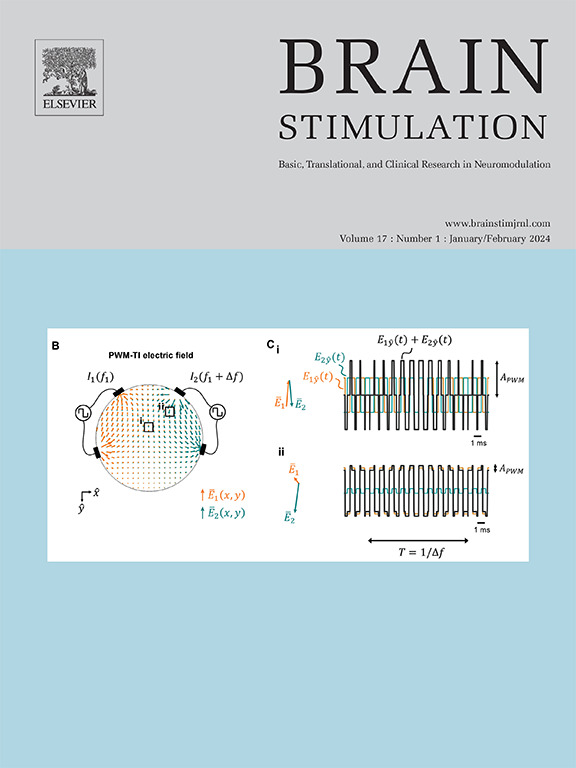Cerebral metabolic rate of oxygen is correlated to treatment effect of electroconvulsive therapy in patients with depression
IF 8.4
1区 医学
Q1 CLINICAL NEUROLOGY
引用次数: 0
Abstract
Background
Neurobiological understanding of the antidepressant mechanisms of electroconvulsive therapy (ECT) is important to advance the treatment. ECT may work by improving depression-related alterations in the cerebral oxygen metabolism.
Methods
21 in-patients with depression treated with an ECT series were examined 1) within two days before, and 2) a few days (median = 4 days) after the last ECT session. Depression severity was assessed by the six-item Hamilton Depression Rating Scale (HDRS-6). Magnetic resonance imaging (MRI) was used to measure 1) global cerebral blood flow (CBF) by phase contrast mapping technique and 2) global cerebral metabolic rate of oxygen (CMRO2) by measuring cerebral extraction of oxygen (A-V.O2) using susceptibility-based oximetry. Statistical analyses were performed using multiple linear regression, adjusting for age and gender.
Results
ECT relieved depressive symptoms from HDRS-6 = 13.9 to 5.2 (p < 0.001), as expected. A larger increase in CMRO2 after ECT was correlated with a better treatment effect (0.5 % reduction in HDRS-6 per 1 % increase in CMRO2, adjusted R2 = 0.24, p = 0.026). The effect was driven by both higher A-V.O2 and increased CBF. Before ECT, an abnormal decoupling between CMRO2 and CBF was observed, which was normalized after the treatment (adjusted R2 = 0.17, p = 0.03).
Conclusions
The treatment effect of ECT for depression was associated with increased CMRO2. Furthermore, ECT restored the normal coupling between CBF and CMRO2. The results suggest that the cerebral oxygen metabolism may be abnormally altered in patients with depression and ECT restores such dysfunction.

抑郁症患者脑氧代谢率与电休克治疗效果相关。
背景:了解电惊厥治疗(ECT)抗抑郁机制的神经生物学原理对推进治疗具有重要意义。ECT可能通过改善抑郁症相关的脑氧代谢改变而起作用。方法:对21例接受ECT系列治疗的住院抑郁症患者进行检查:(1)在最后一次ECT治疗前2天内,(2)在最后一次ECT治疗后几天(中位数= 4天)。采用汉密尔顿抑郁评定量表(HDRS-6)评定抑郁严重程度。采用磁共振成像(MRI)技术测量1)脑血流(CBF)和2)脑氧代谢率(cmoro2) (a - v - o2)测量脑氧提取(a - v - o2)。统计分析采用多元线性回归,调整年龄和性别。结果:ECT缓解了hdr -6 = 13.9至5.2的抑郁症状(p < 0.001),与预期一致。电痉挛后cmoro2增加越多,治疗效果越好(cmoro2增加1%,HDRS-6减少0.5%,校正R2 = 0.24, p = 0.026)。这一效应是由较高的A-V驱动的。O2和CBF增加。ECT治疗前cro2与CBF存在异常解耦,治疗后恢复正常(校正R2 = 0.17, p = 0.03)。结论:ECT治疗抑郁症的效果与cmor2升高有关。此外,ECT恢复了CBF和cmr2之间的正常耦合。结果表明,抑郁症患者的脑氧代谢可能发生异常改变,ECT可恢复这种功能障碍。
本文章由计算机程序翻译,如有差异,请以英文原文为准。
求助全文
约1分钟内获得全文
求助全文
来源期刊

Brain Stimulation
医学-临床神经学
CiteScore
13.10
自引率
9.10%
发文量
256
审稿时长
72 days
期刊介绍:
Brain Stimulation publishes on the entire field of brain stimulation, including noninvasive and invasive techniques and technologies that alter brain function through the use of electrical, magnetic, radiowave, or focally targeted pharmacologic stimulation.
Brain Stimulation aims to be the premier journal for publication of original research in the field of neuromodulation. The journal includes: a) Original articles; b) Short Communications; c) Invited and original reviews; d) Technology and methodological perspectives (reviews of new devices, description of new methods, etc.); and e) Letters to the Editor. Special issues of the journal will be considered based on scientific merit.
 求助内容:
求助内容: 应助结果提醒方式:
应助结果提醒方式:


